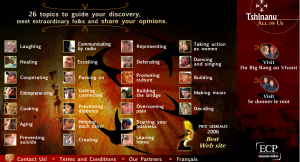New Tribe Magazine
This is a crazy cool magazine geared towards urban Aboriginal youth that is published in Calgary and distributed in Alberta. It is available for free and online in a highly interactive web presentation. The magazine is sponsored by the Urban Society for Aboriginal Youth that is also based in Calgary.
According to the editor, the mission of New Tribe Magazine is “to promote a positive outlook on Aboriginal living in an urban setting by promoting and sharing information within the community.”
Youth are encouraged to contribute to each edition and judging from past editions there are range of writers who have committed themselves to making the magazine a success. The publication is filled with artwork, poetry, news stories from the province and abroad, fictional short stories, advice regarding employment, healthy eating, and wellness (to name just a few). Information is provided about local events and opportunities for Aboriginal youth to connect. In each edition, a young person who is making a difference in the community is profiled (for instance, graphic novelist Mitchell Poundmaker is featured in the May magazine).
Elodie Caron writes a column about Community. Last month, her segment focused on ebooks and readers such as Kindle, Kobo, and ibooks – great stuff ! There are video game reviews, book reviews, and music reviews. All in all, it is a very comprehensive magazine.
Up to 5,000 copies of New Tribe are printed monthly. According to the website, New Tribe has become a main source of information and entertainment for the entire Aboriginal community in Calgary and is not just restricted to youth.
This magazine is very well put together. The online interface is slick and care is put into each edition. The only concern I noticed was that the magazine has a strong entertainment element and sometimes that gives it a very commercialized and westernized vibe. Some of the books and music reviewed have nothing to do with Indigneous culture (review of J-Lo’s latest album). Perhaps, that is not such a bad thing. After all, current Aboriginal culture does not operate within a vacume. I am just concerned that the desire to entertain may make the publication less authentic than it aims to be.

